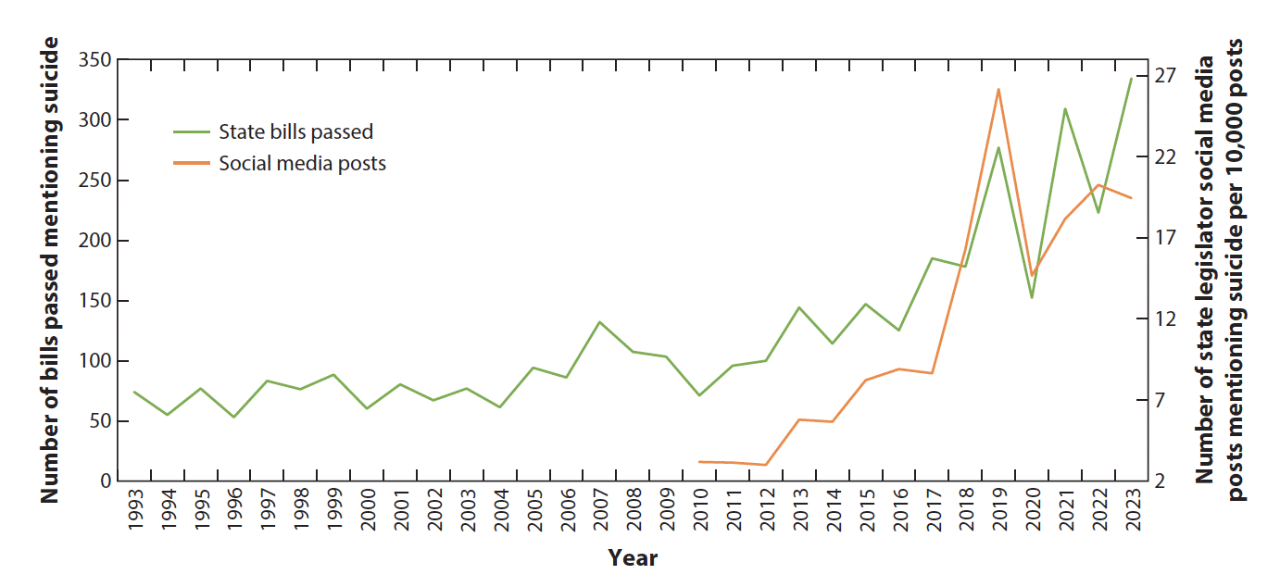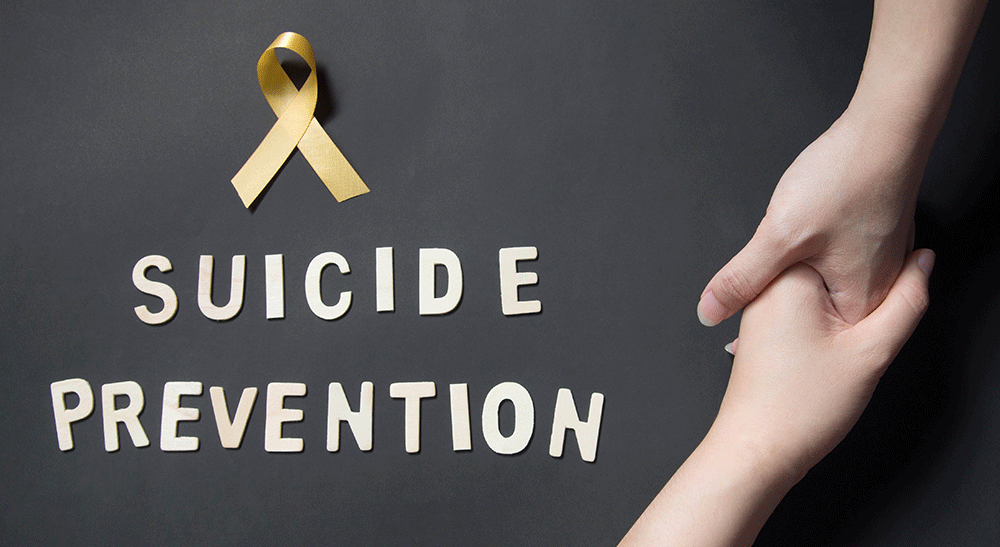A study from researchers at New York University (NYU) determined which public policies effectively prevent suicide deaths in the United States.
In their study, published Jan. 7 in the Annual Review of Public Health, the researchers analyzed the number of state bills passed over the past two decades that mention suicide, as well as the volume of social media posts from state legislators on suicide — a strong indicator of policy priority, according to NYU. Both dramatically increased over the years, particularly starting around 2017. See chart below.

Source: Evidence for public policies to prevent suicide death in the United States. Annu. Rev. Public Health, Vol. 46. doi: 10.1146/annurev-publhealth-071723-121359
“Our analysis suggests that policymakers recognize that suicide is an issue of public health significance and are trying to address it, and there is bipartisan concern,” said Jonathan Purtle, associate professor of public health policy and management at the NYU School of Global Public Health and the study’s lead author.
Suicide rates have also been on the rise over the past two decades, increasing by 37% since 2000, the researchers note. For people ages 10-24, suicide increased by 62% between 2010 and 2020.
NYU Researchers Review Over 100 Studies on Suicide Prevention Policy
The researchers reviewed more than 100 studies and identified three categories of policies that research shows have the potential to prevent suicide:
- Policies that limit access to lethal means (e.g., policies for safe firearm storage and waiting periods to purchase firearms, installing barriers on bridges)
- Policies that increase access to mental health services (e.g., Medicaid expansion, laws requiring insurance to cover mental health care)
- Policies that address underlying risk factors for suicide, including those that increase economic security (e.g., minimum wage laws, paid sick leave, unemployment benefits, supplemental nutrition program), prohibit discrimination (e.g., protecting sexual and gender identity in hate crime laws), and limit access to alcohol and tobacco
Ironically, the analysis found most policies that “demonstrate [suicide prevention] evidence do not mention suicide and were not passed to prevent suicide.”
“They are policies that are intended to address other issues—for instance, increasing minimum wage to promote economic security or reducing alcohol consumption—but they have spillover benefits in that they also prevent suicides,” said Purtle.
RELATED ARTICLE: Tabletop Exercise: Student on School Roof Threatens Suicide
Overall, the researchers found that policies that improve economic security, limit access to alcohol, and restrict access to lethal means have the strongest evidence for suicide prevention.
“Access to alcohol and lethal means of harm, as well as poverty, are all known risk factors for suicide,” said Michael A. Lindsey, Dean and Paulette Goddard Professor of Social Work at the NYU Silver School of Social Work and a study co-author. “Our research suggests that a great starting place for saving lives is to fund and enact public policies that target these three areas.”
Suicide and Access to Firearms
The researchers found that while some of the most effective policies focus on improving well-being in the long term, others, such as those related to firearms and restricting other lethal means, aim to make it more difficult to make quick decisions that can have fatal consequences, says NYU.
Firearms are the most common and deadly method of suicide. According to Prevent Firearm Statistics, firearms are used in half of all suicide deaths and more than half of all youth suicides. Suicide also makes up three in every five gun deaths, and it is almost always deadly with nine out of 10 firearm suicide attempts resulting in death.
RELATED ARTICLE: U.S. Department of Education Issues New Resource for School Administrators on Importance of Safe Firearm Storage
The researchers identified various studies that determined having a firearm in the home dramatically increases the risk of suicide. Although not all firearm policies were found to be equally effective, laws requiring a waiting period for gun purchases were moderately effective at preventing suicides. Laws setting more restrictive age limits for gun purchases and those that require safe gun storage in the home also reduce suicide deaths among young people, the review found.
“Suicide is often an impulsive act,” said Purtle. “Anything you can do to delay that impulsivity on average will be beneficial and will prevent suicide from a public health perspective.”
Researchers Call for More Data on Suicide Hotlines
The study’s authors concluded that more research is needed on suicide prevention, including the effectiveness of the new 988 suicide and crisis hotline.
The researchers also noted more attention is needed on the impact of social media and technology on suicide among young people, and whether school cell phone bans or social media age restrictions make a difference.
RELATED ARTICLE: Surgeon General Warns of Social Media Impact on Youth Mental Health
The U.S. Department of Education recently released a new resource to help states, school districts, and schools adopt policies for student cell phone use. Learn more about the resource here and see which states have enacted cell phone bans or restrictions.
Suicide Statistics for Children, Teens, and Young Adults
According to the American Academy of Pediatrics, national surveillance data suggests that approximately 7-8% of adolescents attempt suicide each year, and about 17% report serious suicidal ideation. Roughly 157,000 people between the ages of 10 and 24 receive emergency medical care for intentional self-inflicted injuries each year.
Youth and young adults ages 10 to 24 years are at an increased risk for suicide. For children ages 10-14, suicide is the second-leading cause of death. Girls are more likely to attempt suicide than boys but boys are four times more likely to die from suicide than girls.
RELATED ARTICLE: Over 40% of LGBTQ+ Teens Considered Suicide in Past Year
Suicide is also the second-leading cause of death for adolescents and young adults ages 15-24.
Among all Americans, suicide is the 11th leading cause of death. In 2022, 49,476 Americans died by suicide, and there were an estimated 1.6 million suicide attempts.
Youth Suicide Risk Factors
According to Hopkins Medicine, suicide risk factors among young people include, among others:
- One or more mental or substance abuse problems
- Impulsive behaviors
- Stressful life events such as bullying or death of a parent
- Family history of mental or substance abuse problems
- Family history of suicide
- Family violence
- Incarceration
- Easy access to guns or prescription medications in the home, among others.
Warning Signs of Youth Suicide
The majority of children and adolescents who attempt suicide have a significant mental health disorder, most commonly depression, according to the American Academy of Child and Adolescent Psychiatry. Hopkins Medicine notes many warning signs of suicide are also symptoms of depression, which include, among others:
- Changing in eating and sleeping habits
- Loss of interest in activities once enjoyed
- Withdrawal from friends or family
- Acting out or running away
- Alcohol or drug use
- Neglecting personal appearance
- Unnecessary risk-taking
- Obsessions with death and dying
- More complaints of physical ailments such as stomachaches, headaches, and extreme fatigue
- Issues focusing
- Lack of response to praise
- Giving away important possessions







